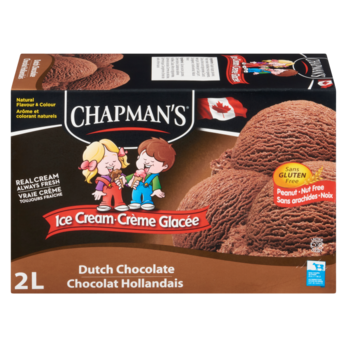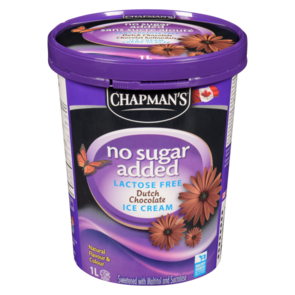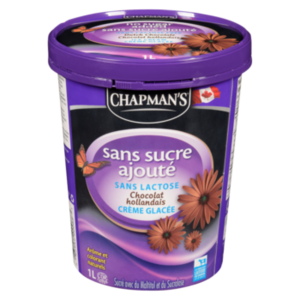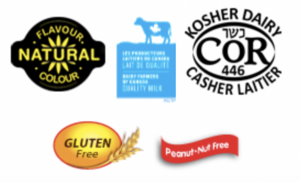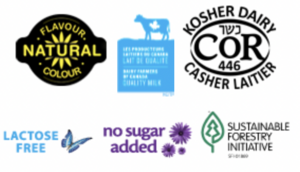Course:FNH200/Assignments/2022/Chapman’s Dutch Chocolate Ice Cream (Original vs. No Sugar Added and Lactose Free)
Brief Description of Food Products
Chapman’s Original Dutch Chocolate Ice Cream
- Smooth and creamy traditional favourite for many
- Made with 100% Canadian Milk
- Peanut/Nut Free
- Gluten Free
- Packed with cocoa flavour.
- No artificial colours or flavours
Chapman’s Dutch Chocolate Ice Cream with No Sugar Added and Lactose Free
- Sweetened with Maltitol and Sucralose (commonly known as Splenda®)
- For low sugar diet
- For those with lactose sensitivity
- Made with 100% Canadian Milk
- Packaging certified to the Sustainable Forestry Initiative
- One of Canada's favourite NSA ice creams
Photos of Food Products
| Original product:
Chapman's Original Dutch Chocolate Ice Cream - 2L |
Zero sugar alternative:
Chapman’s Dutch Chocolate Ice Cream with No Sugar Added and Lactose Free - 1L |
|---|---|
| Product image
|
Product image |
| Ingredient List | Ingredient List |
| Nutritional facts | Nutritional facts |
LabelsIncludes labels for:
|
LabelsIncludes labels for:
|
Ingredient list
| Original product:
Chapman's Original Dutch Chocolate Ice Cream - 2L |
Zero sugar alternative:
Chapman’s Dutch Chocolate Ice Cream with No Sugar Added and Lactose Free - 1L |
|---|---|
|
|
Roles of fat substitutes, sugar substitutes, and/or additives
| Original product:
Chapman's Original Dutch Chocolate Ice Cream - 2L |
Zero sugar alternative:
Chapman’s Dutch Chocolate Ice Cream with No Sugar Added and Lactose Free - 1L |
|---|---|
Fat substitutes
|
Fat substitutes
|
Sugar substitutes
|
Sugar substitutes
|
Additives
|
Additives
|
Role of fat substitutes
- Modified milk ingredients: Modified milk ingredients under the category of protein-based fat substitutes, also known as Simplesse. Based on soy, milk, or egg white protein, Simplesse adds a creamy texture and stabilizes ice cream products to extend shelf life.
Overall, fat substitutes are added to healthier food options in order to preserve the product’s original qualitative attributes such as taste and texture, while reducing the risk of obesity and other health problems from dense fat molecules.
Role of sugar substitutes
- Maltitol syrup: Maltitol syrup is a type of sugar alcohol, which is known to be less sweet than sugar. Sugar alcohols do not contribute to cavities, and high blood glucose or insulin levels. Moreover, maltitol’s high melting point and creamy texture allows for a flavored coating on frozen items.
- Sucralose (Splenda®): Sucralose is a type of non-caloric sweetener that is around 600 times sweeter than sucrose (ie., table sugar). As a non-sugar sweetener, sucralose produces a sweet taste in small quantities, but does not contribute to tooth decay and high amounts of blood glucose or insulin levels.
Overall, sugar substitutes, such as sweeteners and sugar alcohols, have been developed to enhance the taste, texture, and sweetness of food products, without contributing to an excessive caloric intake, tooth decay, cavities, and high blood sugar levels.
Role of additives
- Vegetable gum: Vegetable gum is categorized under the list of “permitted emulsifying, gelling, stabilizing, or thickening agents” in the Food and Drug Regulations in Canada (FDR) Division 16, Table IV. It is a food additive used as a thickener and stabilizer for ice cream products, and is known to aid bowel regularity.
- Mono and diglycerides: Mono and diglycerides are food additives used to prevent milk fat from separating from water or skim milk. As an emulsifier and stabilizer, mono and diglycerides extend shelf life, and improve texture and stability as a thickening agent for ice cream.
- Carrageenan: Carrageenan is also categorized under the list of “permitted emulsifying, gelling, stabilizing, or thickening agents” in the Food and Drug Regulations in Canada (FDR) Division 16, Table IV. When added to chocolate ice cream, carrageenan stabilizes colloidal dispersions formed with cocoa.
Overall, food additives are any chemical substance added to food to preserve or enhance its flavor, texture, appearance, processing, and storage.
Comparing the Original Product with its No Sugar Alternative
| Original product:
Chapman's Original Dutch Chocolate Ice Cream - 2L |
Zero sugar alternative:
Chapman’s Dutch Chocolate Ice Cream with No Sugar Added and Lactose Free - 1L | |
|---|---|---|
| Sweetening agent(s) |
|
|
| Sugar substitute(s) |
|
|
| Fat substitute(s) |
|
|
| Food additives: emulsifying, gelling, stabilizing and thickening additives |
|
|
There are surprisingly many similarities in ingredient lists between the classic and zero-sugar alternatives of Chapman’s Dutch Chocolate Ice Cream. For instance, both products contained modified milk substitutes (Simplesse), fresh cream, cocoa, vegetable gum (carob bean gum, cellulose gum, guar gum), mono and diglycerides, carrageenan, and vanilla extract.
Considering the No Sugar Added, Lactose-free Dutch Chocolate ice cream product is targeted towards healthier and/or individuals more prone to health complications, this zero-sugar alternative contained two substitutes to sugar and glucose to reduce the risk of high calorie, fat, and sugar. For instance, while the Original Dutch Chocolate ice cream uses sugar and glucose as its sweetening agents, the No Sugar Added, Lactose-free Dutch Chocolate version uses maltitol syrup and sucralose as sweeteners instead. Maltitol syrup is a type of low-calorie sweetener, while sucralose is non-caloric. These types of sugar substitutes are known to reduce calories and sugar content, while maintaining a similar sweetness and pleasurable experience as the sugar in the Original Dutch Chocolate product.
Another method to reduce health risks in ice cream is to reduce fat content. It was interesting to note that both products contained modified milk ingredients (ie., Simplesse). Simplesse is a protein-based fat substitute added to ice cream to stabilize and give a creamy texture to it.
The main takeaway of this comparison is that the label of “no sugar added, lactose free” in the zero sugar ice cream alternative by Chapman’s is misleading, considering its original counterpart contains similar kinds and amounts of ingredients, and actually contains more calories than its apparent “zero sugar” version with half its portion.
Labels and Compliance with Regulatory Requirements
| Original product:
Chapman's Original Dutch Chocolate Ice Cream - 2L |
Zero sugar alternative:
Chapman’s Dutch Chocolate Ice Cream with No Sugar Added and Lactose Free - 1L | |
|---|---|---|
| Bilingual labeling | All mandatory information on the label shows both official languages (ie., French and English). | All mandatory information on the label shows both official languages (ie., French and English). This is seen in the front and back of the packaging. |
| Common name of the food product | Ice Cream (as indicated in the bold font) | No Sugar Added, Lactose Free Ice cream (as indicated in the larger text and bold font) |
| Country of origin | Indicates “made with 100% Canadian Milk” and “Proudly Canadian Company”, contains a Canadian flag in packaging | Indicates “made with 100% Canadian Milk” and “Proudly Canadian Company”, contains a Canadian flag in packaging |
| Date marking, storage instructions, and durable life | The “Best Before” label can be found on the side of the box. The packaging indicates its type of storage with the “frozen” label. | The “Best Before” label can be found at the bottom of the tub. The packaging indicates its type of storage with the “frozen” label. |
| Identity and principal place of business | The packaging includes the brand name “Chapmans”, contact number, post office box, and website | The packaging includes the brand name “Chapmans”, contact number, post office box, and website |
| Irridiated ingredients | No irridiated ingredients | No irridiated ingredients |
| Legibility and location | All information is clear and legible | All information is clear and legible |
| Nutrition facts table | The label shows the Nutrition Facts table in both English and French. The percent daily value (DV%) and grams/milligrams per ¾ a cup (188 mL) is indicated for fats, carbohydrates, protein, cholesterol, sodium, vitamins, and minerals.
|
The label shows the Nutrition Facts table in both English and French. The percent daily value (DV%) and grams/milligrams per ¾ a cup (188 mL) is indicated for fats, carbohydrates, protein, cholesterol, sodium, vitamins, and minerals.
|
| Net quantity of the food | The net quantity of food is indicated in large, bold text at the bottom corner of the box: 2L | The net quantity of food is indicated in large, bold text at the bottom of the tub: 1L |
| Sweeteners | None | Maltitol syrup, sucralose (Splenda®) |
| Food additives (permitted by FDR) | Vegetable gum (carob bean gum, cellulose gum, guar gum), mono and diglycerides | Vegetable gum (carob bean gum, cellulose gum, guar gum), mono and diglycerides |
| Other mandatory information |
|
|
Labeling requirements, such as the Consumer Packaging and Labelling Act and Regulations and the Food and Drugs Act and Regulations, have been required on pre-packaged domestic and imported food products by the Canadian Food Inspection Agency (CFIA). Comparing the labels of the Dutch Chocolate Original Ice Cream and No Sugar Added, Lactose Free Dutch Chocolate Ice Cream by Chapman’s, both food labels meet all requirements set out by the regulations. Moreover, both products comply with the standards of food identity and composition–indicating that the labels accurately identify the food product and present lists of mandatory and permitted ingredients in the ice cream. More detailed product information may also be found on their website: https://www.chapmans.ca/
Personal Choice (3 points)
Please submit your individual component of this assignment on Canvas to protect your privacy and your personal opinion
References
- Chan, Judy. "2.2.1 Food Major Components".
- Chan, Judy. "2.2.2.4 Vitamins and Minerals"
- Chan, Judy. "3.1 Fat and Sugar Substitutes"
- Chan, Judy. "3.2 Sensory Properties of Foods"
- Chan, Judy. "4.1 Food Standards, Regulations and Guides"
- Chan, Judy. "4.3 Food Labelling Requirements"
- Chan, Judy. "4.4 Standards of Food Identity and Composition"
- Chan, Judy. "4.7 Food Additives"
- Chapman's 2022 - A Canadian Family Company. "Dutch Chocolate Ice Cream"
- Chapman's 2022 - A Canadian Family Company. "Dutch Chocolate Ice Cream (No Sugar Added)"
- Government of Canada. "4. List of Permitted Emulsifying, Gelling, Stabilizing or Thickening Agents (Lists of Permitted Food Additives)"
| This Food Science resource was created by Course:FNH200. |
